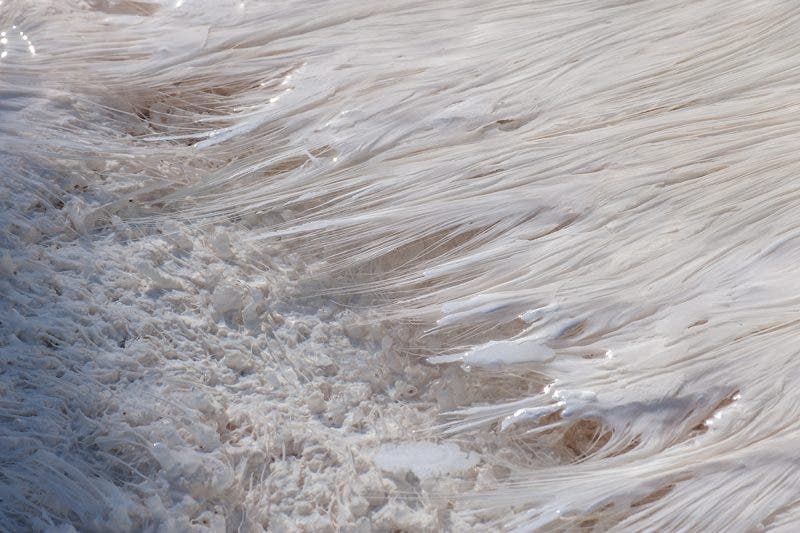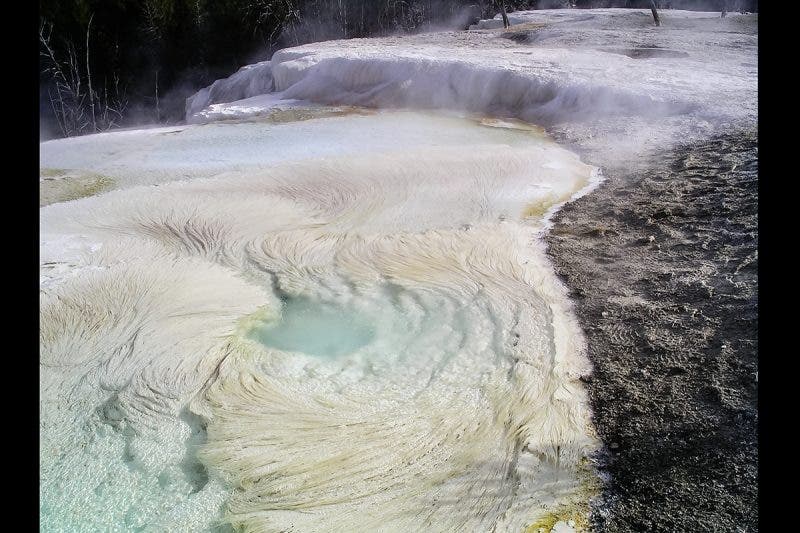
It’d be fantastic to visit another planet and be greeted by friendly little green aliens. It really would, but that’s just projecting popular culture. Alas, when we’ll finally find the first extraterrestrial life forms — if such a milestone ever occurs — in all likelihood, these will be microbes. Not just any boring-looking, amoeba-shaped microbes though. According to scientists at the University of Illinois at Urbana-Champaign, alien microbes or their fossils for that matter could look like fettuccini or capellini.
That’s how some hot-spring-loving microbes are shaped here on Earth, and if you ever visited Yellowstone National Park, you may have seen signs of them. The nation’s largest national park is dotted by hot geothermal water flowing from the ground, which is rich in minerals. These minerals precipitate, forming fibrous structures of calcium carbonate called travertine.
When Bruce Fouke, a geobiologist at the University of Illinois at Urbana-Champaign, visited Mammoth Hot Springs in the park, he found that the travertine looked like, well, pasta. Focusing on the head of the mineral spring, where the water is particularly hot (65 to 72 degrees Celsius) and more acidic, Fouke’s team sampled filamentous microbe mats. These pasta strands owe their shape to the rushing nature of the hot water spring, which forces organisms to cling to one another in order to survive, whereas in calmer water microbes settle in unconsolidated, slimy mats. Each thread consists of trillions of microbes, which thrive where 99.99% of all other life forms would have perished.

After taking a sample to the lab, the researchers found that the pasta mats are formed by Sulfurihydrogenibium yellowstonense, or “sulfuri” for short. True to their name, these bacteria break down sulfur compounds, producing hydrogen sulfide gas in the process and energy for themselves in order to survive. Proteins on the surface of these microbes react with the mineral-rich waters, encouraging the growth of calcium carbonate crystals and speeding up the formation of travertine a billion times faster than in other environments. Where there’s pasta-shaped travertine, you’ll find sulfuri, and vice-versa.
“They form tightly wound cables that wave like a flag that is fixed on one end. These Sulfuri cables look amazingly like fettuccine pasta, while further downstream they look more like capellini pasta,” Fouke said.
Sulfuri represents one of the oldest types of life on Earth, having evolved more than 2.5 billion years ago when Earth was a hellish planet with barely any oxygen in its atmosphere. And although any alien microbes living in hot springs will undoubtedly be of a different species, they would probably look and behave a lot like Earth’s sulfuri given the limited number of ways carbon-based life can work in such extreme environments.
Should a rover encounter pasta-shaped travertine on another planet like Mars, these rock formations could be treated as fossils. The unique morphology of the travertine would make it quite easy to spot too.
“This should be an easy form of fossilized life for a rover to detect on other planets,” Fouke added.
“If we see the deposition of this kind of extensive filamentous rock on other planets, we would know it’s a fingerprint of life. It’s big and it’s unique. No other rocks look like this. It would be definitive evidence of the presence of alien microbes,” the scientist added.
So far, we’ve yet to find filamentous travertine in Mars, but the now-defunct Spirit rover did find some odd cauliflower-shaped silica formations in the Gustav Crater, a region thought to have once harbored ancient Martian hot springs. These rocks resemble those shaped by microbes on Earth, actually at Yellowstone National Park where the silica contains the fossilized remains of microorganisms. Unfortunately, Spirit became unoperational before it had the chance to investigate further. Elsewhere at Gale Crater, the Curiosity rover found sedimentary rocks that seem to have signs of possible microbial mats. However, Curiosity doesn’t have the necessary hardware to make a proper analysis.
Perhaps the new Perseverance rover, which arrived on Mars in 2021 at Jezero Crater, will be luckier. Hopefully, it will be treated to a nice dish of fettuccine pasta by some Martian chef.
The findings were reported in the journal Astrobiology.
Was this helpful?



